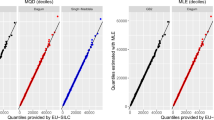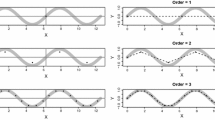Abstract
Grouped data have been widely used to analyze the global income distribution because individual records from nationally representative household surveys are often unavailable. In this paper we evaluate the performance of nonparametric density smoothing techniques, in particular kernel density estimation, in estimating poverty from grouped data. Using Monte Carlo simulations, we show that kernel density estimation gives rise to nontrivial biases in estimated poverty levels that depend on the bandwidth, kernel, poverty indicator, size of the dataset, and data generating process. Furthermore, the empirical bias in the poverty headcount ratio critically depends on the poverty line. We also undertake a sensitivity analysis of global poverty estimates to changes in the bandwidth and show that they vary widely with it. A comparison of kernel density estimation with parametric estimation of the Lorenz curve, also applied to grouped data, suggests that the latter fares better and should be the preferred approach.
Similar content being viewed by others
References
Abdelkrim, A., Duclos, J.-Y.: DASP: distributive analysis stata package. PEP, World Bank, UNDP and Université Laval. Available online at http://dasp.ecn.ulaval.ca/ (2007)
Ackland, R., Dowrick, S., Freyens, B.: Measuring global poverty: why PPP methods matter. The Australian Demographic and Social Research Initiative Unpublished Manuscript, Australian National University, Canberra (2008)
Andrews, D.F., Bickel, P.J., Hampel, F.R., Huber, P.J, Rogers, W.H., Tukey, J.W.: Robust Estimates of Location: Survey and Advances. Princeton University Press, Princeton (1972)
Bandourian, R., McDonald, J.B., Turley, R.S.: A comparison of parametric models of income distribution across countries and over time. Rev. Estad. 55, 164–165 (2003)
Bourguignon, F., Morrisson, C.: Inequality among world citizens: 1820–1992. Am. Econ. Rev. 92(4), 727–744 (2002)
Chen, S., Ravallion, M.: The developing world is poorer than we thought, but no less successful in the fight against poverty. Q. J. Econ. 125(4), 1577–1625 (2010)
Chen, S., Datt, G., Ravallion, M.: POVCAL, A Program for Calculating Poverty Measures for Grouped Data. World Bank Poverty and Human Resource Division, The World Bank Group, Washington (2001)
Chotikapanich, D., Griffiths, W.E., Rao, D.S.P.: Estimating and combining national income distributions using limited data. J. Bus. Econ. Stat. 25, 97–109 (2007)
Datt, G.: Computational tools for poverty measurement and analysis. IFPRI Food Consumption and Nutrition Division Discussion Paper No. 50, International Food Policy Research Institute, Washington (1998)
Deheuvels, P.: Estimation nonparamétrique de la densité par histogrammes généralisés. Rev. Statist. Appl. 25, 5–42 (1977)
Diaz-Emparanza, I.: Selecting the number of replications in a simulation study. Unpublished Manuscript, University of the Basque Country Department of Economics and Statistics. Available online at http://129.3.20.41/eps/em/papers/9612/9612006.pdf (1996)
Diaz-Emparanza, I.: Is a small Monte Carlo analysis a good analysis? Checking the size, power, and consistency of a simulation-based test. Stat. Pap. 43(4), 567–577 (2002)
Domma, F., Perri, P.: Some developments on the log-dagum distribution. Stat. Methods Appl. 18(2), 205–220 (2009)
Fuentes, R.: Poverty, pro-poor growth and simulated inequality reduction. UNDP Human Development Report Office Occasional Paper No. 11, United Nations Development Programme, New York (2005)
Heston, A., Summers, R., Aten, B.: Penn world table version 6.3, center for international comparisons of production, income, and prices at the University of Pennsylvania. Available online at http://pwt.econ.upenn.edu/php_site/pwt_index.php (2009)
Jann, B.: Univariate kernel density estimation. Statistical Software Component No. S456410, Department of Economics, Boston College, Boston (2007)
Jones, M.C., Marron, J.S., Sheather, J.S.: A brief survey of bandwidth selection for density estimation. J. Am. Stat. Assoc. 91, 401–407 (1996)
Kakwani, N.C.: On a class of poverty measures. Econometrica 48(2), 437–446 (1980)
Kakwani, N.C.: Functional forms for estimating the lorenz curve: a reply. Econometrica 44(1), 1063–1064 (1980)
Kleiber, C.: A guide to the dagum distributions. In: Chotikapanich, D. (ed.) Modeling Income Distributions and Lorenz Curves, Economic Studies in Inequality, Social Exclusion, and Well-Being. Springer New York (2008)
Li, Q., Racine, J.S.: Nonparametric Econometrics: Theory and Practice. Princeton University Press (2006)
Lopez, J.H., Serven, L.: A normal relationship? Poverty, growth and inequality. World Bank Policy Research Working Paper No. 3814, The World Bank, Washington (2006)
Marron, J.S., Nolan, D.: Canonical kernels for density estimation. Stat. Probab. Lett. 7, 195–199 (1988)
Marron, J.S., Ruppert, D.: Transformations to reduce boundary bias in kernel density estimation. J. R. Stat. Soc., Ser. B (Methodological) 56(4), 653–671 (1994)
McDonald, J.B.: Some generalized functions for the size distribution of income. Econometrica 52, 647–663 (1984)
Milanovic, B.: Global inequality recalculated: the effect of new 2005 PPP estimates on global inequality. J. Econ. Inequal. (forthcoming)
Milanovic, B.: True world income distribution, 1988 and 1993: first calculation based on household surveys alone. Econ. J. 112, 51–92 (2002)
Milanovic, B.: Worlds Apart: Measuring International and Global Inequality. Princeton University Press (2005)
Minoiu, C., Reddy, S.: Kernel density estimation from grouped data: the case of poverty assessment. IMF Working Paper No. 183, International Monetary Fund, Washington (2008)
Minoiu, C., Reddy S.: Estimating poverty and inequality from grouped data: how well do parametric methods perform? J. Income Distrib. 18(2), 160–179 (2009)
Mosteller, F.: On some useful inefficient statistics. Ann. Math. Stat. 17(4), 377–408 (1946)
Ott, R.L., Longnecker, M.: An Introduction to Statistical Methods and Data Analysis, 6th Edition. Duxbury Press (2008)
Pinkovskiy, M., Sala-i-Martin, X.: Parametric distributions of the world distribution of income. NBER Working Paper No. 15433, The National Bureau for Economic Research, Cambridge (2009)
Reddy, S., Pogge, T.: How not to count the poor. In: Anand, S., Segal P., Stiglitz, J. (eds.) Debates on the Measurement of Global Poverty, Oxford University Press (2010)
Sala-i-Martin, X.: The world distribution of income: falling poverty and ... convergence, period. Q. J. Econ. 121(2), 351–397 (2006)
Sheather, S.J., Jones, M.C.: A reliable data-based bandwidth selection method for kernel density estimation. J. R. Stat. Soc. Ser. B (Methodological), 53(3), 683–690 (1991)
Silverman, B.W.: Density Estimation for Statistics and Data Analysis. Monographs on Statistics and Applied Probability, vol. 26, Chapman & Hall/CRC (1986)
Stigler, S.M.: Linear functions of order statistics with smooth weight functions. Ann. Stat. 2(4), 676–693 (1974)
Villasenor, J.A., Arnold, B.C.: Elliptical lorenz curves. J. Econom. 40, 327–338 (1989)
Wand, M.P., Jones, M.C.: Kernel Smoothing. Chapman and Hall, London (1995)
World Bank: Povcalnet online database. The World Bank Group, Washington. Available online at http://go.worldbank.org/7X6J3S7K90 (2010)
Wu, X., Perloff J.: GMM estimation of a maximum entropy distribution with interval data. J. Econom. 138(2), 532–546 (2007)
Yatchew, A.: Nonparametric regression techniques in economics. J. Econ. Lit. 36(2), 669–721 (1998)
Zhang, Y., Wan, G.: Globalization and the urban poor in China. UNU-WIDER Working Paper No. 2006/42, United Nations University, World Institute for Development Economics Research, Helsinki (2006)
Author information
Authors and Affiliations
Corresponding author
Electronic supplementary material
Below is the link to the electronic supplementary material.
Rights and permissions
About this article
Cite this article
Minoiu, C., Reddy, S.G. Kernel density estimation on grouped data: the case of poverty assessment. J Econ Inequal 12, 163–189 (2014). https://doi.org/10.1007/s10888-012-9220-9
Received:
Accepted:
Published:
Issue Date:
DOI: https://doi.org/10.1007/s10888-012-9220-9




